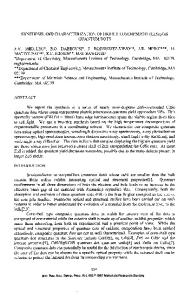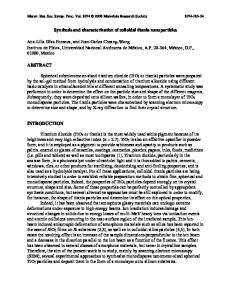ZnS nanoparticles synthesis and characterization
- PDF / 794,240 Bytes
- 6 Pages / 612 x 792 pts (letter) Page_size
- 45 Downloads / 421 Views
N11.23.1
ZnS nanoparticles synthesis and characterization Yvonne Axmann1, Alke Petri1 and Heinrich Hofmann1 Powder Technology Laboratory, Materials Science and Engineering Department, Swiss Federal Institute of Technology, EPFL, CH-1015 Lausanne, Switzerland 1
ABSTRACT ZnS:Mn2+ nanoparticles were synthesized via a wet chemical method with L-cysteine as the stabilizing agent. The obtained aqueous dispersions show an orange luminescence, which is typical for the 4T1 → 6A1 transition within the Mn2+ d-orbitals. The fluorescence quantum yield has been determined with quinine sulphate as a dye reference. It can be increased after formation of a SiO2 shell around the particles by a factor of three. The particle size was determined with transmission electron microscopy (TEM), X-ray diffraction and PCS measurements.
INTRODUCTION Fluorescence is a widely used tool in biological and medical analysis. Conventional dye molecules impose stringent requirements on the optical system used to make these measurements. Their narrow excitation spectrum makes simultaneous excitation difficult in most cases, and their broad emission spectrum with a long red tail introduces detection problems [1]. Furthermore, for multicolour experiments it is not possible to excite a whole group of molecules with only one laser, which would be the ideal case. Another disadvantage of these organic dyes is the so-called photobleanching, i.e. the fluorescence degradation during UV exposure. These problems could be overcome with inorganic semiconductor nanocrystals. Here the excitation over the band gap leads to a broad excitation spectrum and the fluorescence is emitted in a narrow and symmetric spectrum either by recombination of the electron and the whole over the band gap (e.g. CdSe, CdS) or by d-orbital transitions for doped semiconductors like ZnS:Mn2+. In the first case different colours for multicolour experiments can be achieved by varying the particle sizes since the band gap energy increases with decreasing particle size, in the second case by variation of the dopand. On this article we present Mn2+ doped ZnS as a model system for doped semiconductor nanoparticles.
EXPERIMENTAL DETAILS All chemicals were analytical reagent grade and were used without further purification. Ultrapure deionised water (Seralpur delta UV/UF setting, 0.055 µS/cm) was used in all synthesis steps. D-9527 Sigma cellulose membrane dialysis tubing with a molecular weight cut off at 12’000 was used in all dialysis steps. Fluorescent, L-cysteine coated ZnS:Mn2+ nanoparticles were prepared by precipitation of the sulphide from aqueous solution in the presence of the surfactant. To do this, solutions of ZnSO4·7H2O (1M, in 0.01M HCl), L-cysteine (0.25M) and MnCl2·4H2O (0.01M, 0.1-0.35 mol%) were mixed and the ZnS:Mn2+ precipitated with a Na2S·xH2O (pH 13.5) (1M, S2-/Zn2+ ratio of 2.0) solution in a N2 atmosphere without stirring. Due to the basic shock with the Na2S
N11.23.2
injection Zn(OH)2 precipitates first. The formed white precipitate slowly redisolves under formatio
Data Loading...











